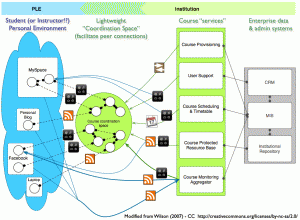In the ever-expanding search for ways to visualize the “new” PLE environment, I ran across Scott Wilson’s latest visual (posted back in Nov 2007). I have to noodle on this a lot more, but it sure points out the “murky land” between…
He explains this to encapsulate ““…. the set of connections between what an institution offers and what individuals manage”.
I re-arranged this a bit for my use, so I thought I would re-post it here. Any messing up of the original is my fault and my apologies in advance to Scott for this.
He’s certainly right – these new systems are not like VLE’s/LMSs we deal with now. We are starting to see some possibilities with the SOA model… I also still struggle a bit with the difference between the coordination space and a portal… Mabe its becuase my concept of a portal is so different than that of the reality of portals.
To me the portal should be the flexible interface that allows us to put things together (ala netvibes) but the reality is a bit too rigid. Sigh.
What I am still trying to figure out is how we make this concept “manageable”. People who are immersed in the Web 2.0 world understand that there is a beautiful order and simplicity in this “chaos”. Those that are used to a world of well-bounded systems shake their head and shudder.
I can’t wait for the day where are institutional identity and portal systems catch up….


Hi Michelle, I don’t want to put words in Scott Wilson’s mouth, so obviously any mis-interpretations here are mine, but I understand the “coordination” space as a ‘bridging’ type space/app, something that is a mid-point between the fully disaggregated personal spaces and more centralized spaces we now have. For instance, I think D’Arcy’s eduglu prototype represents a good example of this; it *can* simply serve as an aggregator/tagger, the content of which is consumed elsewhere, but in as much as it is built on top of Drupal, it also offers its own sets of capabilities (for instance for those who do not wish to have their ‘own’ spaces), and it can also offers affordances for connecting students and teachers around more formal axis (whereas there personal spaces/networks may only reflect a small portion of the institution’s formal perspective). So, for instance, as a mechanism to find info on the rest of a pre-defined ‘cohort’and connect with them (which doesn’t pre-empt the *personal* in PLE, but in my mind, sits alongside it, bridging it. At least that is how I am understanding the diagram/concept.
I take your comment about “manageability” at face value and as such as very valid. I think at times it used as the thin edge of many IT-driven FUD campaigns against these kind of de-centralized approaches, but I don’t think that’s how you are using it. This *isn’t* that tidy. It probably *does* need to get simpler, and certainly I think any *specific instance* of it will in fact be simpler (remember, Scott’s diagram is working to describe an overall phenomenom, not a specific instance of it). Us edubloggeeks do presume too much sometimes, and I think it’s entirely likely that we sometimes overstate the case for freedom and choice when sometimes students (and instructors) might really actually prefer something more simple, dare I say, more monolithic. But if we overstate the case, perhaps some of that can be understand as a reasonable reaction to what seems like the absolutely atrocious (and ‘one off’) interface we subject learners to in our current CMS, now knowing that we don’t *need* to do it only this way like maybe we first thought we did. (As an aside, and you’ve heard me say this before, I like to remind people that modern web-based CMS are maybe 15 years old; who are we kidding by trying to convince people we got it right the first time).
Sorry for the long comment, I’m at an IT conference and this seemed like a much better use of my time 😉 Cheers, Scott
Long comment? No worries! I’m glad that people still know where I am after so long! Thank you!
I think this is the direction we’re moving (and like it), but am puzzling through how to make it straightforward – while appreciating we’re in a messy time.
Those of us in technology have time to think through this… the challenge is translating to those who don’t have the time to think through it; we need to be able to explain in very practical terms why someone would move to using this approach. We also have to be careful how we approach rolling out such an approach and work with those that are used to messy… while supporting a broad set of people who just need the “basics”. The practical side often boils down to being able to demonstrate (not discuss) how this saves time or helps improve what a person is doing – and saves time….”
The technology piece is the easiest piece (as usual)….
I’d love to hear more success stories on this, and to see implementation approaches.
Very cool stuff…